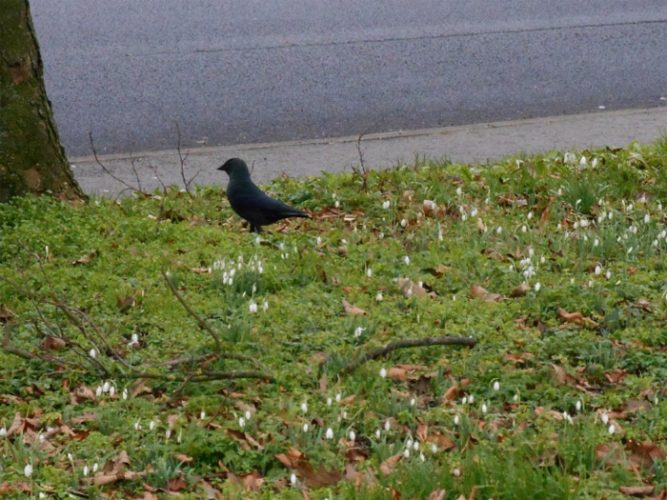February 2017
By Sandra Gibson
Photograph by Geoff Edwards
Crow Black
Crow on the rough grass –
just me and the crow,
so largely there.
Crow fly
low fly
crow fly
heavy.
Heavy
blows
the iced wind.
I walk through a bleak park in open-skied winter and on some days there are two iridescent magpies, and on other days a lone black crow, pecking the damp mud, then rising his serrated wings in heavy flight to land on slate. I always regret his going away from me. The crow is my favourite bird.
I went to an August wedding party at a castle in County Kilkenny and at red sunset the piper played a mournful sound on the ramparts. The whirling crows completely lost the plot and could not settle on the trees; they were disorientated by this strange new sound, and for the duration it seemed as if the piper was raising strange forces, and the black whirring birds were smudging the rosy sky of dusk.
One languid summer’s afternoon I heard the distinctive cawing of crows heightened in aggressive tension. A buzzard had entered their territory and three crows – how small they seemed – were mobbing it repeatedly and noisily until it eventually flew off. In spite of their size, buzzards are relatively delicate and don’t risk physical contact. Crows don’t have many predators but they will drive off buzzards, owls and occasionally herons when protecting young.
Corvids are found throughout the world and in varied environments including coastal areas, woodland, moorland and urban developments. Their relationship with humans is interesting. They can distinguish individuals by recognising facial features and will transmit squawking disapproval for anyone thought to be ‘bad’ but they will show appreciation by giving ‘gifts’ too. The creation of the scarecrow tells you all you need to know about their status with farmers. In hard times poor people have relied on crows for food: a tradition that re-emerged after the First World War. Fishermen too, collected their eggs and preserved crow meat by salting and smoking it.
Crows are rated highly amongst the world’s intelligent creatures, having an encephalisation quotient equal to many primates. They can use tools: twigs, and sometimes metal wire, to impale larvae, and bread as bait for fish. They are one of the few creatures who are capable of displacement: like ants and bees they ‘comment’ on things not spatially or temporally present. At a Technology Entertainment Design conference in 2008, Joshua Klein suggested a new potential use for a vending machine. The idea was that crows would be trained to pick up waste, and deposit it in the machine in exchange for dispensed food. I don’t know if this was ever put into practice, but I can imagine the omnivorous crows organising for gourmet pay and a feather-bed pension scheme.
*Also known as Rose Bay Willow Herb, the prolific wild flower called Fireweed, five feet tall with spikes of magenta flowers, cheers the hearts of those whose cityscape has become a bomb site or whose buildings have been cleared by machine. The dormant seeds spring to life after destructive events such as forest or man-made fires, hence the name, Fireweed. This occasional column will celebrate the persistence of wildlife in urban conditions.

Permalink
Just fabulous! I will view crows differently in the future .